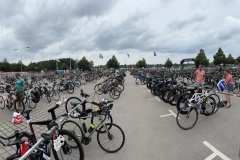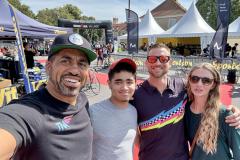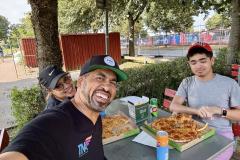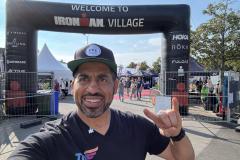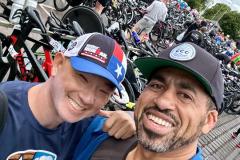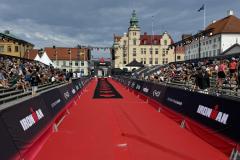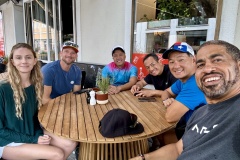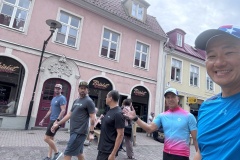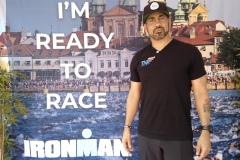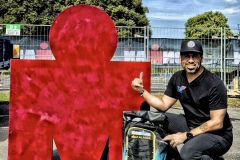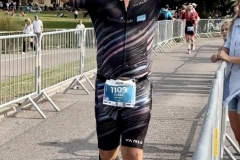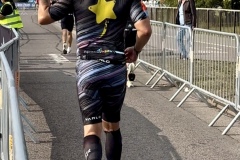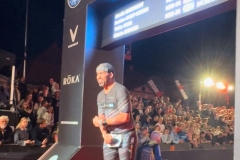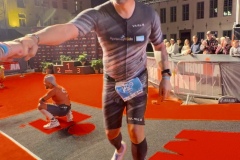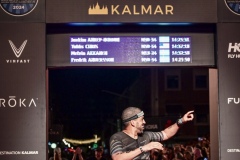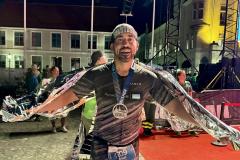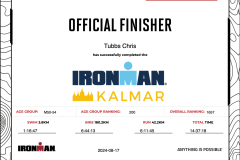This was my second international Ironman. My first attempt, Ironman Cozumel, ended poorly and with a DNF (Did Not Finish). I realized as I’ve gotten older, my body has difficulty regulating its core temperature. Since I tend to generate a lot of heat when I exercise, the combination of heat and decreased ability to cool down affects my performance and could lead to a health emergency. I decided to look for cooler race courses that fit my work schedule and eventually chose Kalmar. My family was on board with the choice, as we’ve never visited the Nordic countries. I also informed my triathlon club, and a few weeks later, five other members decided to join the race. It’s better to suffer with friends, right? Additionally, I decided to race for something bigger than myself. I re-connected with the Apraxia-kids.org to raise awareness and funds for them.
After completing the registration process, we were faced with the usual decisions. We needed to determine how long we wanted to stay, what accommodation options were available, and how we could reach the small town of Kalmar. Since the local airport was too small, we would have to take connecting flights, which increased the risk of losing or delaying our gear and my bike. Therefore, I chose to rent a bike. This would minimize the risk of encountering major issues if my bike got lost or damaged during transit.
Check-in and pre-race prep
On the Wednesday before the race, we flew from Houston directly to Amsterdam and connected to Copenhagen that night. The next morning, we drove four hours to Kalmar. Getting to the race venue only a day and a half before a full-distance Ironman made me anxious. I did the best that I could to stay settled and adapt.
When we arrived in Kalmar, we went straight to the Ironman Village so that I could check in and pick up my La Pierre Aerostrom TT rental bike from France Bike Rentals. I knew the bike would need to be adjusted, ridden, and fine-tuned. I brought my Assioma power pedals, seat, and aero bars to make the bike feel more comfortable, but unfortunately, the rental didn’t accommodate the aero bars, pads, or my specific seat. So, I installed my pedals and chose a similar seat. There were some significant differences: the cranks were 175 mm vs the 172.5 mm that I use, the seat was not easily adjustable, and the aero pads were small and thin, with the stack being quite a bit higher than my bike. However, I was excited about how the rental bike felt – it was at least 50% lighter than my QR4. Additionally, there was something new for me to try: Di2 electronic shifters. After picking up my athlete bag and purchasing a t-shirt (which didn’t have my name on the back), we played trunk Tetris to fit the bike into the car with all our suitcases, then headed out to check into our bed and breakfast on the island adjacent to Kalmar.
On Friday morning, before dropping off my race bags and bike, I went for a ride to check how well the bike fit. I noticed that the bike felt fast and easy, but I felt unstable when sitting in the aero position. After about 2 minutes, I figured out that the longer cranks were causing me to hit myself in the chest, and the seat was too close to the handlebars, so I was scrunched up while in the aero bars. I knew the seat needed to be moved back quite a bit, but I could do nothing about the cranks so close to race day. If I raised the seat to allow my hips to be more open, I would be too high for the aero bars. I returned the bike to the FBR tent and had them adjust the seat backward. Unfortunately, the frame wasn’t big enough to move the seat far enough back to give me the proper distance to the elbow pads, so I ended up having the seat 4-5cm closer than usual. This setup came back to affect me significantly during the race. Nonetheless, I decided to make the best of what I had and took the bike to transition to organize my bags and drop everything off.
While preparing to drop off my gear bags, Thomas told me we were meeting for lunch, so I left my stuff in the car and walked with him to meet the others. We had lunch at a lovely Italian restaurant in Kalmar’s central district. We took a few moments to recognize the upcoming race and enjoyed our pasta. Afterward, we went our separate ways to finish our preparations. I returned to our bed and breakfast. I felt quite anxious, but it was more of an excited uncertainty. I even talked about these feelings with my wife, wondering if anxiety and excitement are essentially the same, just interpreted differently based on the narratives we create for ourselves. Despite this, I knew I was physically prepared and mentally focused on this race more than ever, and I went to bed around 8:30 pm.
The Swim
I woke up at 3:30 AM and ate 100g of carbs from oatmeal. Then, I had some coffee while visualizing the race. We left the house at 4:30 AM to make sure we were in transition when it opened at 5 AM. It’s always calm at that time, and the bathrooms have no lines. I must keep my stress levels from spiking two hours before the race begins. The setup had the bikes away from the bike and run gear bags, so I had to be more thoughtful about how things were organized and set up before heading to the swim start.
After dropping off my morning clothes bag, I took a short walk to the pier. This is where the fun begins, and the race energy builds. This race is known for its fantastic swim environment. They start with the Swedish national anthem, announce the list of the most represented countries (there are athletes from 77 countries at this event), and then start with the professional women. Fifteen minutes after they depart, it’s our turn. They fire a real cannon to set off the first wave, and then we jump in 4-5 every 4 seconds.
I started at the rear of the 1:05-minute group. I aimed to finish from 1hr 08 min to 1 hr 10 min. We left the docks and swam in a zig-zag pattern through the harbor. It was annoying, but we got to see and hear the crowds almost the entire swim. They were sitting along the walls of the harbor, clapping and yelling. It was a great distraction for me. The water was a refreshing 64 degrees and very mildly brackish, so I felt at home. I had been focusing on developing good form leading up to this race, aiming to finish in less than 1:10 while maintaining a zone 2 effort. I kept my heart rate below 140, which, in retrospect, was too low. I wasn’t even tired at the end. Normally, my lower back hurts, my shoulders are fatigued, and I’m ready to transition to my bike. But this time, I was clear-headed and very aware during the swim. I focused on keeping my hips high with a very light kick, keeping my head down while regularly sighting and breathing every stroke, and feeling the synchronicity of my hips and shoulder rotation with each stroke. If I felt shoulder strain, I knew I wasn’t rotating and engaging my lats enough, so I refocused on that part of my technique. Learning to breathe and tolerate more rapid breathing through regular yoga practice paid off when I had to speed up or miss a breath due to the occasional chop. Overall, I didn’t feel like I was pushing hard enough or moving as fast as I had planned, but I didn’t have the confidence to kick another gear up. Lesson learned.
Emerging from the water, I stood up too quickly and took my first step, only to fall over. After that, I felt fine—my heart rate was low, my body was relaxed, and I was satisfied with what seemed like a good swim. The transition entrance was very near, but I didn’t properly organize my gear bags. I got some bike stuff in the run bag and confused myself. So, I sat on the bench, took a few breaths, and considered what I needed for the next phase. I knew I was taking a long time, but I didn’t want to forget anything.
Finish time: 1hr 16 min 47 sec
The Bike
The weather was cool, so I put on my arm covers to keep warm and prevent sunburn. I looked forward to following through with the plan on a lightweight bike that didn’t fit well. I didn’t see my wife or son as I finished the swim, so I hoped to spot my son’s red hat as I left the transition area. The crowds were dense and extended far outside the transition area. Despite keeping an eye out, I never caught sight of them. We swiftly departed from Kalmar, crossed the 4-mile-long Öland Bridge, and entered Öland, where I would ride the race’s first 110 kilometers (out of 180 kilometers). My bed and breakfast was on this island, so I anticipated good roads and open countryside for the entire stretch.
Very quickly, I realized that getting into the aero position would not work for more than a few minutes at a time. When I did, I would knee myself in the stomach/chest with each pedal stroke, and my lower back got angry very quickly. But the bike was fast. I was holding 18-20 Mph with much less effort than I ride my QR at home, which felt good but was also unsettling. My training plan (Tridot.com) told me to hold 208 watts. I didn’t feel confident, so I adjusted it to average 180-185 watts and paid attention to how my body felt the entire time. Part of the loss of confidence is due to previous races where I struggled to hold my goal power of 160 watts. I really couldn’t wrap my head around that large of a jump in less than a year.
After realizing I couldn’t ride in an aero position, I took a deep breath and focused on my power, cadence, hydration, and fueling. The scenery was beautiful, with people outside everywhere – sitting in lawn chairs, on benches, and standing with their signs written in Swedish. The atmosphere, with temperatures in the low 70s and a light breeze, made it feel like an easy ride. There were moments when I found myself effortlessly maintaining 245 watts without feeling fatigued. My legs were spinning, and I was fully present in the moment. My mind was relaxed and focused on the plan. I acknowledged that I might end up with a slower pace than expected because sitting up made me like a big parachute punching through the wind. However, I didn’t mind. As long as I stuck to the plan, the time and pace were secondary. I reminded myself to stay aware and be fully present in the moment.
I ensured enough fuel and hydration on my bike for the first three hours so I didn’t need to stop at aid stations. However, after passing the third aid station, I took a quick break and grabbed a bottle of water and a couple of Maurten gel packs. I wanted to give my body a break from the high-carb drinks, so I drank one bottle of cold water. I made sure to continue taking the PF Chews every 20 minutes. When I consumed about 3/4 of my second carb drink, I picked up a bottle of electrolytes from the aid station. Although I didn’t have to do this, my bottles were getting warm, and I wanted to mix them with something cooler. I usually train with the PH 1500, so drinking those bottles would be fine. The new flavor was a welcomed change, too.
The headwinds kicked in hard once we completed the southern portion and cut across to the eastern side to head north. The island has about four trees, so nothing can stop the wind as it comes off the water. I hadn’t studied the route map well enough to know precisely where we were, so I couldn’t anticipate when we might turn out of the headwind. Surprisingly, I still felt very good, so I reminded myself to keep riding and fueling. Because I couldn’t sit in the aero position, holding myself upright was taking a toll on my hands and arms. My wrists were aching because I was up on the bars, blocking all the wind for the athletes behind me the whole time.
During the race, I noticed two tri-club buddies passing me around mile 40 or 50. We chatted a bit, and one suggested I go with them and take advantage of the 25-second drafting rule. I almost did, but then I realized they were moving too quickly for me to keep up while staying close to my goals, so I decided to let them go. The remainder of the ride went well, but it was uneventful, except I noticed I was consistently around 225 watts. Instead of sticking to what felt good, I lost confidence and decreased to around 180 watts. Although I didn’t feel much fatigue in my legs, I wasn’t sure if I was strong enough to maintain the higher power. It turned out I was, but I was unwilling to take the risk. In previous races, I struggled to hold 165 watts, so accepting such a significant change was difficult, and I chose to listen to the doubt. Moving forward, I’ll better listen to my body and remember what I had achieved in training rather than being influenced by past race experiences. Just before reaching the dismount line, I saw my wife and son, and even she remarked that I looked surprisingly fresh.
Finish time: 6hr 44 min 13 sec
The Marathon
I took my time in T2 assessing how my body was handling the demands. My legs showed no signs of fatigue, I wasn’t overheating, and I was in a very good mood. The next step was to check for dehydration by stopping in the port-o-potty to piss. Typically, when I begin the marathon, my urine is dark yellow, indicating significant dehydration. Today, I’m pissing a light yellow stream… I’m good to go! So far, I’m racing well and setting myself up for a strong PR finish.
Covering a distance of 26.2 miles is quite extensive, and many things can change over such a long distance.
This is where things get serious for me. I have dedicated a lot of time to improving my running form and mechanics, as well as changing my mindset to see myself as a strong and confident runner. The process is working, but progress is slow. I was fully aware that I would face mental and physical challenges along the way. I aimed to acknowledge when these challenges arose, assess my situation realistically, and make adjustments. I realize the best way to change my old negative mindset is to continue pushing through tough times and not give in to negative thoughts.
I started at a comfortable pace, intentionally slowing down at times. I aimed to maintain an 11-11:30 min/mile pace until my body relaxed. Sitting on an ill-fitting bike for 6.5 hours made me feel tighter than usual. Once I felt more comfortable, I increased my pace to sustain a 10:30-10:45 min/mile pace for the first 13 miles. I had done this before, so I was confident about maintaining that effort. Everything was going well for the first 10 kilometers. Then, suddenly, I was overcome with nausea, and my hamstrings started cramping. Negative thoughts started creeping in at that point, and I struggled to run the rest of the first loop.
When I returned to the town square to start my second loop, the cheering crowd gave me energy, and I felt strong again. I realized that I wasn’t hitting a wall, nor getting too hot, and still felt physically capable. My main struggle was mental, along with some nausea and occasional hamstring cramps that were getting more frequent. I regained my confidence when I ignored my watch and began running based on how I felt, and comfortably maintained a pace of 9:45-10:00 per mile. This showed me that I was physically capable and my body was willing to keep going. However, I lacked the confidence to continue running based on feel. I believed I needed to hold back my effort. I mentally fought against that by thinking about the kids with Apraxia, who are always fighting for their voices. Feeling physically strong also helped, but I couldn’t escape the negative mental struggle for long periods, so I had ups and downs throughout the second loop. This yo-yo process damaged my confidence, and I found myself walking more than running, constantly questioning myself. Not as much as in the past, but more than I would have liked.
As I started the third and final lap, I noticed that my body wasn’t nearly as fatigued as it had been during previous full-distance races. I didn’t feel completely exhausted, either. My feet hurt, and my quads, hamstrings, and hip flexors were the primary pain points. I think they were hurting so much because of the unusual cycling position. This experience showed me how much my fitness had improved and how well I could regulate my effort during the event. Every time I ran past my wife and son, it boosted my energy. My wife would also keep me informed about how I was doing. Despite all the difficulties, I was on pace to finish in under 13 hours. I needed to maintain a consistent pace. While I did slow down a little on the second lap, I believed I could persevere for the third.
Unfortunately, I faced a setback during the final lap of the race. I started running the first mile or two but then had to walk due to hamstring pain. I tried my best to keep going mentally, but I was also dealing with nausea. The distance between my run-walk intervals was getting shorter because my hamstrings cramped more frequently and intensely, even when I walked. Despite the challenges, I didn’t want to give up. While finishing in under 13 hours was no longer possible, I aimed to achieve a personal record by finishing in under 14 hours. To do that, I needed to run 8 miles in about an hour and a half, but the problem was that I was averaging a 14-minute mile or slower, even with the run-walk approach. Although the nausea had subsided, my hamstrings were not cooperating.
As I pushed through the last four miles, I realized that the sub-14-hour goal was no longer attainable. So, I chose to walk and talk with a Swedish athlete who had raced the course six times. He was experiencing some of the same issues (severe nausea, bonking, and cramping), and we passed the time getting to know one another. After acknowledging that we would finish whether we walked or ran, the pressure just disappeared. We shared race stories and the importance of our families in the process of doing these long races. Our attitudes shifted from failing to meet our objectives to feeling grateful for our lives, health, and support systems and capable of doing these crazy events.
As we returned to the town square, the crowds were still very loud, and my energy level went up again. I ran the last half-mile, stopping to give hugs and congratulations to my friends who had finished and were waiting for me just ahead of the red carpet. As I jogged onto the red carpet, the bright lights, the announcer, and the crowd’s roar caused a release of all the emotions. My eyes watered; I smiled and was filled with an immense sense of joy. I had done it, not exactly as planned, but it was a well-executed race, and I felt very good.
Finish time: 6 hr 11 min 45 sec
Total time: 14 hr 37 min 18 sec
The Lessons
- I have recently reached a turning point in my athletic abilities. This means that my physical fitness and race intelligence are higher than I had expected or was willing to accept. However, I’ve come to realize that my race performance is currently limited by the beliefs I hold about my capabilities. The times I achieved during my recent race made this very clear to me.
- I finished the race one hour faster than the previous Ironman (Ironman Texas 2022), which was itself one hour faster than the one before it (Ironman Florida 2021). I love the progress.
- Focusing on swim technique rather than raw speed is proving effective for me. I will continue with this approach, aiming for a one-hour Ironman swim finish without entering high zone 3.
- Please remember the following: Don’t rent a bike! Instead, take it regardless of the inconveniences incurred. The consequences during the race are not worth the easier travel days. Now that I know how much difference a light bike can make, I’ll start looking to lighten or upgrade my bike.
- In the past 9 months, I have significantly improved my strength and endurance by focusing on indoor cycling training. While I enjoy outdoor cycling, I plan to balance indoor and outdoor sessions strategically. My upcoming race, Ironman Lake Placid, features challenging hills, so I will work on building my climbing capacity over the next nine months.
- I will continue to improve as a runner. Pushing myself into the “doubt” zones during training has helped me rewrite my negative narratives and build confidence in my abilities while on my feet.
- Get a pair of good distance running shoes. I still haven’t figured out this aspect of the marathon.
- Arrive at full-distance races at least four days before the event. If it’s an international race, five or more days is even better. Accounting for the time zone difference is critical.
- Racing for apraxia-kids.org changed the race experience. While on the course, when I began to think, “This is getting hard; I better ease up,” I remembered that I was representing the charity and why I chose them. Remembering that I was racing for something bigger than myself allowed me to draw more inner strength. Also, I was very proud to have “apraxia-kids.org” on my kit. I heard many people saying it out loud. Raising awareness was one of the main goals. The other was to generate donations. Together, we raised a little over $3500!
- After finishing the race, I felt fantastic and full of energy. Although my legs and feet were hurting, I wasn’t completely exhausted. It became clear to me that I had been too cautious during the race. I had followed my nutrition plan perfectly and didn’t hit the wall. If anything, I had consumed too much fuel while running, which made me feel nauseous.
- Having friends and family on the course was incredibly important. Their support boosted my morale and reminded me that I was also demonstrating discipline, dedication, and the courage to pursue ambitious goals.
